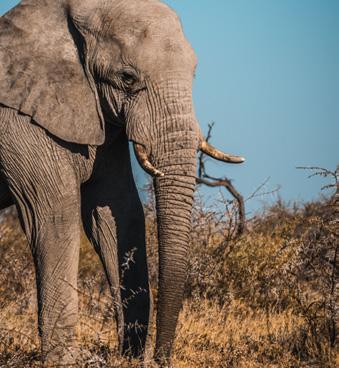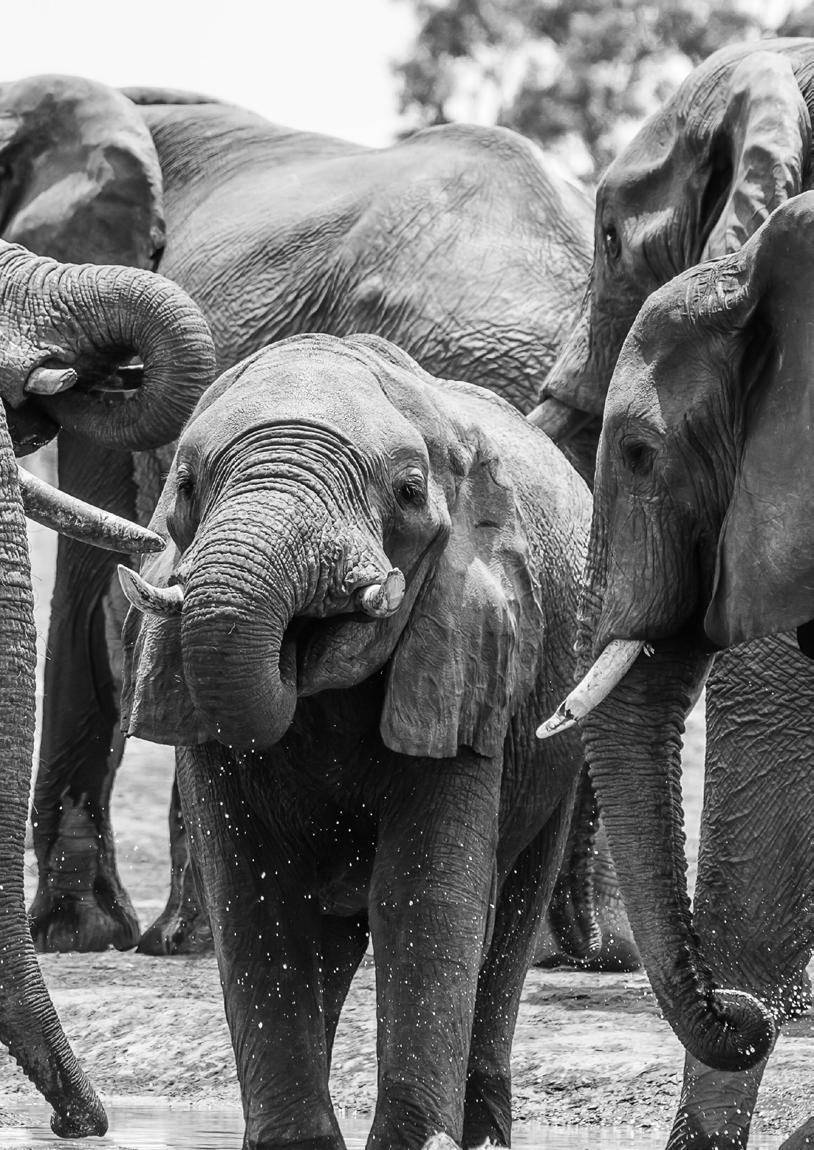
14 minute read
Appendix II – Background Information
A. BOTSWANA ELEPHANT MANAGEMENT PLAN 2021 – 2026
The process to develop the Botswana Elephant Management Plan 2021 – 2026 (BEMP) began in June 2018 with national consultation workshops taking place in Nata, Selebi Phikwe, Kasane, Ghanzi, Seronga and Maun. Technical workshops were subsequently held from 24 June to 24 July 2018. The process to develop the BEMP has been a multi-stakeholder consultative process including communities living in the elephant range, community organisations engaged in CBNRM, and the non-state actors—safari operators, NGOs, IGOs, academic institutions, and independent researchers—who are working or have worked in Botswana.
Advertisement
The BEMP takes on board the changes and lesson learned over the last twenty years of elephant conservation. Many factors have changed over the years including the Botswana elephant population almost tripling since 1990. Moreover, the BEMP addresses regionally accepted elephant management strategies and priorities (e.g. KAZA) and draws on elephant management plans from other elephant range states with similar track records of successful elephant conservation. Adaptive management forms the basis of implementation and is used for determining effectiveness of the BEMP. B. PREVIOUS ELEPHANT MANAGEMENT PLANS

The Conservation and Management of Elephants in Botswana Plan (CMEBP) 1991 – The objectives of the 1991 plan included the sustainable use of elephants and to maintain their numbers at their 1990 level of about 55 000 animals. Maintenance of woodlands and biodiversity was an important objective. Resolving HEC was also a priority.
Multiple use objectives were achieved but HEC continued at an unacceptable rate, elephant populations were not kept at their 1990 levels nor were woodlands maintained at their 1990 status.
The National Policy and Strategy for the Conservation and Management of elephant in Botswana 2003 – This document examined issues and options for elephant management on the basis of wide consultations with stakeholders both within the elephant range and countrywide. Elephant management objectives varied in different parts of the country according to the impacts of elephants on livelihoods and habitats, on aesthetic values and on scientific information. These ranged from laissez-faire in areas where elephants were the primary wildlife attraction to complete removal where their impact on livelihoods and habitats were considered excessive. HEC mitigation was an important objective.
Wildlife Legislation
The Wildlife Policy of 1986 – This Policy was reviewed in 2013 and is intended to guide and support future wildlife conservation and utilisation activities. The policy upholds wildlife as a valuable land-use option, confers better protection of wildlife resources, aims to reduce human wildlife conflict, upholds animal welfare and provides incentives for management of wildlife resources by the public.
The Wildlife Conservation and National Parks Act, first enacted in 1992 (Chapter 38.01, amended in 1993 and revised in 1996) – This Act remains key in protecting Botswana’s wildlife resources. The law provides for the conservation and management of wildlife through the establishment of protected areas and game farms, it includes schedules to differentiate between protected animals and partially protected animals, and it provides for control in hunting through the issuing of hunting quotas and licences. The Act also domesticates provisions emanating from CITES. Enforcement of the implementation of the Wildlife Conservation and National Parks Act is achieved through two sets of regulations: (i) National Parks and Game Reserves Regulations of 2000 and (ii) Wildlife Conservation (Hunting and Licensing) Regulations of 2001.

Forestry Legislation D. International Conventions, Agreements and Policies
Forest Policy of 2011 – This Policy defines basic principles, objectives, strategies and action plans which provide guidance and facilitation in the management of forests and range resources through conservation, development and sustainable use to meet social, cultural, economic, environmental and ecological needs of present and future generations.
The Forest Act – This Act first enacted in 1968, is the principle legislation in Botswana to manage areas of forest and regulate the harvest and use of forest products. The Act provides for better regulation and protection of forests and forest produce but it only focuses on areas designated as forest reserves and state land. A revision of the Act will be merged with the Forest Act (1968), the Agricultural Resources Conservation Act (1974) and the Herbage Preservation (Fire Prevention) Act of 1977.
CUSTOMS LEGISLATION
The Customs and Excise Duty Act of 1970 (Act No. 22 of 1970; Amended up to Act No. 31 of 2004) – This Act provides guidance for customs-related matters relating to all products, including wildlife.
PENAL CODE
The Penal Code, 1964 (Law No. 2 of 1964; amended up to Act. No. 14 of 2005) – This Law makes provisions with respect to procedure and evidence in criminal cases. Botswana is a member and party to various organisations and agreements:
• The Southern African Regional Police Chief
Council Organisation (SARPCCO) • The World Customs Organization since 25
August 1978, with the relevant government authority being the Botswana Unified Revenue Service (BURS) • A bi-lateral trade agreement with neighbouring Zimbabwe • Southern African Customs Union Agreement with Lesotho, Namibia, South Africa and Swaziland • The Eastern and Southern Africa Anti-Money Laundering Group, which is associated with the Financial Action Task
Force (FATF) • The UN Convention against Transnational
Organized Crime • The UN Convention against Corruption • Party to the Convention on Biological Diversity • Party to the Ramsar Convention on Wetlands • The African Wildlife Consultative Forum (AWCF) • The World Summit on Sustainable Development (WSSD) • The New Partnership for Africa’s Development (NEPAD) • The Southern African Regional Police Chief
Council Organisation (SARPCCO) • The World Customs Organization since 25
August 1978, with the relevant government authority being the Botswana Unified Revenue
Service (BURS) • A bi-lateral trade agreement with neighbouring
Zimbabwe • Southern African Customs Union Agreement with Lesotho, Namibia, South Africa and
Swaziland




E. INTERNATIONAL COOPERATION
F. TRANSBOUNDARY CONSERVATION AREAS
To address elephant management challenges, Botswana and other elephant range states cooperate through the African Elephant Action Plan that was approved at the CITES 15th Conference of the Parties (CoP 15) in Doha, Qatar in 2010.
Botswana has hosted a number of international conferences to address and reach agreements on elephant management challenges: • 2013 African Elephant Summit to discuss the growing illegal ivory trade and its impacts on
African elephant populations • 2015 Conference on Illegal Wildlife trade to reach agreements to combat wildlife crimes by strengthening legislation and reducing demand for ivory • 2019 KAZA African Elephant Summit to discuss
HEC, illegal and legal trade. KAZA is situated in a region where the international borders of five countries converge. It includes a major part of the Upper Zambezi basin and the Okavango basin and Delta. The zone includes the Kavango and Zambezi (formerly Caprivi) regions of Namibia, the south-eastern corner of Angola, south-western Zambia, the core elephant range in the north of Botswana and western Zimbabwe. The centre of this area is at the confluence of the Chobe and Zambezi Rivers where the borders of Botswana, Namibia, Zambia and Zimbabwe meet. It incorporates Hwange National Park and the Victoria Falls in Zimbabwe, and the Okavango Delta and Chobe National Park in Botswana, Makgadikgadi/Nxai National Park and Moremi Game Reserve.
The initiative was created in cooperation with Peace Parks Foundation and the World Wide Fund for Nature. It developed from the Okavango–Upper Zambezi International Tourism Initiative (OUZIT) and the “Four Corners” Trans-boundary Natural Resource Management initiative.
A strategic planning framework was developed for elephant management and conservation in KAZA during a workshop that took place in Kasane in August 2018. Participants formulated a strategic planning framework with five objectives:
1. Objective 1 – Facilitate the development of an integrated land use planning process to secure longterm ecosystem integrity and connectivity of KAZA’s elephant population, 2. Objective 2 – Maintain and manage KAZA’s elephants as one contiguous population, 3. Objective 3 – Promote and support co-existence of humans and elephants for ecological, social and economic benefits, 4. Objective 4 – Reduce the illegal killing and trade in elephants and elephant products, and 5. Objective 5 – Establish a high-level decision-making process on which to build the planning framework for conserving KAZA’s elephants.


THE WILDLIFE
Based Economy

Although Botswana’s GDP is dominated by agriculture (2%) and industry (30%), the tourism industry has diversified the economy, and, growing at 3.4%, it now contributes 11% to the GDP. The increase in international tourism receipts (% of total exports) increased from 7.3% in 1995 to 13% in 2016.
Tourism provides 8.9% of the total formal employment although higher paying management level positions have been filled by expatriate workers (Mbaiwa 2017b).
Most of Botswana’s tourist attractions are its National Parks and Game Reserves and their wildlife inhabitants which bring large numbers of international visitors to see them. There are concerns from local people that while tourism has led to considerable infrastructure and economic development, the negative impacts of tourists on wildlife and the environment can be significant.
Numbers of international safari hunters are smaller than numbers of photographic tourists. Their economic contribution may, however, be significant as they are required to pay not only for hunting licences but also quota fees, costs of taxidermy, professional hunter as well as the costs normally incurred by photo tourists. Their impacts on the environment are lower and are not considered biologically significant.
Mbaiwa (2017a) analyzed the income of Communities through safari hunting and wrote: “Prior to the hunting ban, communities involved in safari hunting generated huge sums of money annually through the sale of hunting quotas to professional hunting outfitters. In community areas 2008, safari hunting generated P7, 382,097 while photographic tourism generated only P 2,374,097 (Johnson, 2009 in Mbaiwa 2017). Between 2006–2009 safari hunting by communities generated P 33, 041,127 while photographic tourism generated only P 4,399,900 (Johnson, 2009). Data obtained
from DWNP indicate that in 2011/12, about P35, 517, 534 was generated by CBNRM projects in Botswana. Safari hunting by communities generates almost two-thirds of the tourism revenue compared with photographic tourism which generates only a third of community revenue (Johnson 2009; Mbaiwa 2015). Income generated by communities from safari hunting is used to support livelihoods in respective communities (Arntzen et al., 2003; Mbaiwa and Stronza, 2010). In addition, the BWMA (2001) argues that 49.5% of revenue from the safari hunting industry is used in the local district, 25.7% at the national level and only 24.8% was being paid overseas mainly in the form of agents’ commissions and profits. Conversely, only 27% of photographic tourism revenue is being retained within Botswana while the rest is leaked outside the country (Barnes, 1998).In this regard, BWMA argues that safari hunting benefits local communities more than photographic tourism.”
A major study done by Mead (2001) put the gross economic value of the safari hunting industry in Botswana at about US$10 million. Martin (2008) estimated that this value has increased to about US$40 million using the same parameters of Mead (2001).
The nature of the industry changed considerably between 2001 and 2008 mainly because of the larger quota of trophy elephants available (330 in 2008 versus 180 in 2000) and by the marketing changes forced upon safari operators to be able realize the value of the quota.
About 88% of the value generated in Botswana’s wildlife sector is from land occupied by elephant (Barnes 2001; Mead 2001, Martin 2008). However, the proportion of economic value in the wildlife sector attributable to elephant is difficult to determine. Excluding citizen hunting, elephant values have been confined to tourism (safari hunting, and non-consumptive wildlife viewing). It has been suggested that elephant contributed around 33% to the value of safari hunting in Botswana in 2000 and about 60% in 2008.

The following form is designed for monitoring tusk weight and must be completed by safari operators following each hunt. These are minimum requirements for monitoring trends in trophy quality. If practical, an additional column should be added for the measurement of circumference at lip level
Elephant Trophy Hunting Monthly Return Form (complete one row per animal)
WEIGHT kg
Date Sex Permit # Left Right TOTAL Jaw tag # CHA/ Location Professional hunter
Name of client Nationality
Terms of Reference for the National Elephant Conservation and Management Committee and the National Elephant Coordinator

Function: To annually review the Action Plan for Elephant Management and Conservation in Botswana and progress in implementing the Action Plan; to review budget and policy decisions by the Elephant Coordinator; to guide the Ministry of Environment, Natural Resources, Conservation and Tourism and its Department of Wildlife and National Parks to assume overall executive responsibility for elephant conservation and management in Botswana.
Role of Individual Committee Members : The role of the individual
members includes:
• Understanding the strategic implications and outcomes of initiatives being pursued through the Action Plan Outputs; • Appreciating the significance of the Action Plan’s implementation for major stakeholders and for the future of elephant conservation; • Being committed to and actively involved in, implementing the most efficient and effective Action Plan; • Being willing to suggest changes to the Action Plan to achieve efficiency and effectiveness.
Duties : The Committee’s primary responsibilities include:
• Ratifying major technical decisions concerned with elephant conservation and management; • Developing and implementing elephant policy;
• Ensuring the successful implementation of all required actions; • Advising the Elephant Coordinator and DWNP on sourcing of funds; • Monitoring funding, expenditure and effectiveness.
Composition : The members of the National Elephant Management Committee include:
• Director DWNP (Chair); • Elephant Coordinator (Secretary); Representatives of DWNP,
MENT, CBOs, Botswana Police, Botswana Defence Force, DIS,
Ministry of Agriculture and Food Security, Ministry of Land
Management, Water and Sanitation Services, HATAB, BOGA,
NGOs, Independent researchers and BWPA.
Time Frame:
The Committee will meet at least twice a year, and can be called upon to meet more frequently as the need arises.
Minutes and Meeting Papers:
Minutes will be kept by the Elephant Coordinator. Minutes will be circulated within one week of Committee meetings. Resolutions and action points will be kept by the Elephant Coordinator. Actions may be taken without a meeting by a signed unanimous consent circulated, compiled, and maintained by the Elephant Coordinator.

Quorum Requirements:
A quorum exists when [75%] of the Committee members are present.
B) Terms of Reference for the National Elephant Coordinator (Draft)
Function : To coordinate elephant management in Botswana; to work with stakeholders including the National Elephant Committee, communities, private landowners, safari operators, NGOs and independent researchers
Duties : The Elephant Coordinator’s duties include: • Coordinating major technical decisions concerned with elephant conservation and management; • Developing and implementing elephant policy; • Ensuring the successful implementation of all required actions; • Perform the duty of Secretary of the National Elephant Committee; • Liaising with stakeholders; • Collecting, collating and disseminating required reports under the Action Plan.



CONTACTS
The Director Department of Wildlife and National Parks Headquaters PO BOX 131 Gaborone Tel: 3971405 Fax: 3912354 Email: dwnp@gov.bw
Parks and Reserves Reservation Office PO Box 131 Gaborone Tel: 391 1405 Fax: 318 0774 Email: dwnpreservations@gov.bw
The Principal Botswana Wildlife Training Institute PO Box 368 Maun Tel: 686 0376 Fax: 686 3049

Regional Wildlife Officer Central District Department of Wildlife and National Parks PO Box 679 Serowe Tel: 463 0443 Fax: 463 5935 Regional Wildlife Officer Ngamiland District Department of Wildlife and National Parks PO Box 11 Maun Tel: 686 0368 Fax: 636 0053
District Wildlife Officer Kgalagadi District Department of Wildlife and National Parks PO Box 4 Tsabong Tel: 6540280 Fax: 654 0221











